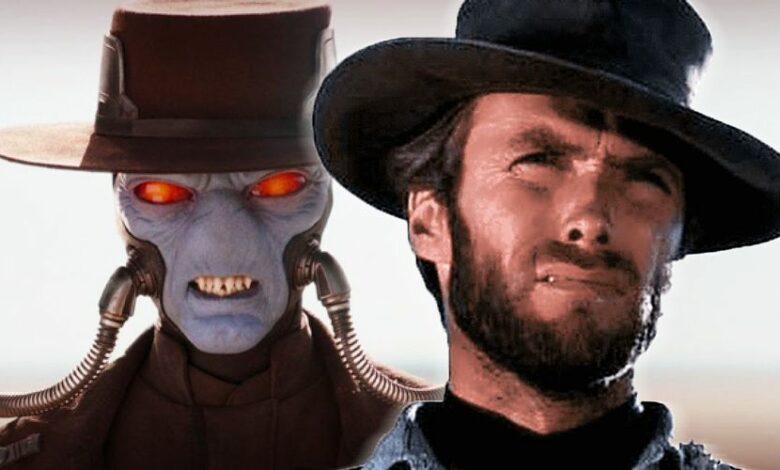Every fan of the Star Wars galaxy has heard the term “space Western” thrown out to describe the franchise. That phrase has stuck for a reason, as it perfectly encapsulates the inspirations flooding George Lucas’ mind when creating the Original Trilogy. Lucas is not coy when speaking about his inspirations being drawn from Samurai films and mid-20th century Westerns like A Fistful of Dollars. When returning to his greatest story during development for Star Wars: The Clone Wars, Lucas, along with Dave Filoni and Henry Gilroy, took inspiration from another film in Clint Eastwood’s “Dollars Trilogy” when creating a new bounty hunter.
That bounty hunter is, of course, the deadly Cad Bane, a character who recently made his brief live-action debut in Disney+’s The Book of Boba Fett. The blue-skinned gunslinger owes a lot to the trilogy of spaghetti Western films, but one character from the series’ final film, The Good, the Bad and the Ugly, directly influenced his look, demeanor and grit. Representing “the Bad” in the film’s title was Lee Van Cleef’s iconic Angel Eyes, who very well may be Earth’s version of Cad Bane.

When watching Van Cleef as Angel Eyes in The Good, the Bad and the Ugly, the similarities between the two characters are striking. The cold-blooded killers share so many qualities, from their signature grimaces to their infatuation with earning money at the cost of others’ lives. Between their famous wide-brimmed hats and Bane’s devilish red eyes giving a wink to “The Bad’s” name, Angel Eyes, Lucas was practically begging for fans to make the connection. It seems like the only thing missing is Van Cleef’s truly superb mustache.
Cad Bane was introduced in 2009 during the Season 1 finale of The Clone Wars. This was a strong call on the creatives’ end because his inclusion intrigued fans at the potential for a new iconic Star Wars villain, which was honestly something the series desperately needed at the time. During the episode, titled “Hostage Crisis,” Cad Bane proves himself not only to be a physical threat but a mental one as well, much like Angel Eyes, who’d often play mind games to get a step ahead.
Cad Bane’s live-action appearance in The Book of Boba Fett dripped with Western nostalgia right from the get-go. As Cobb Vanth looked out across the Tatooine desert to see a shadowy figure approaching, it wouldn’t have been out of place for a tumbleweed to roll through the shot. The slow tilt up of Bane’s head that revealed the ruby-red eyes below his wethered hat felt lived in and something directly out of a Sergio Leone storyboard. Even the episode’s title, “From the Desert Comes a Stranger,” sounds like the name of a forgotten Western sitting in someone’s VHS collection.

The ambiance of Star Wars has always been influenced by the immortal images captured by directors like Leone, Kurosawa and Eastwood. The scum and villainy living on the streets of a certain Daimyo’s Mos Espa are the same types of characters that would be seen clearing out of Dodge just before a shoot-out. Cad Bane’s emergence into the Star Wars canon only continues that tradition and is truly a welcomed addition.
Some may see this inspiration as a direct rip-off on Lucas’ part, as the influence is so heavy-handed in the series. However, the same is true for Kurosawa, who watched American Westerns when prepping to create his films, which went on to influence Leone when creating Angel Eyes. At this moment, it is unclear if Cad Bane’s appearance in The Book of Boba Fett will be his last. Hopefully not, as his presence carries on a tradition that started in the original trilogy, and it was honestly a weak way for such a terrifying figure to go out.
